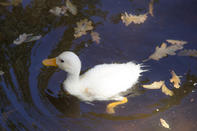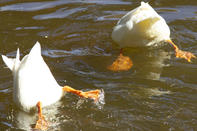Duck farming specifically for meat production is a small yet growing industry in South Africa.

Challenges that may develop relate to disease management (particularly bird flu), market development, and competition against imported products.
The farming of ducks for down and feather production is a distinct farming system to the production of meat. The information below briefly looks at meat production and also features the importance of water for ducks, regardless of the farm’s production focus.
Duck Farming Systems
Ducks bred for meat are farmed by only a few producers in South Africa, mostly with a combination of indoor and outdoor farming systems.
Ducks can be farmed on large-scale indoor facilities as is the case in Europe and the UK where duck farmers are required to provide litter (an absorbent material to absorb excretions) and access to open water. In the USA, ducks are mostly farmed indoors with floors made from slats which allows the excretions to fall through and be cleared away.
In South Africa, ducks for meat are predominantly produced in free-range farming systems - a combination of indoor growing areas and outdoor areas for bathing and foraging. In practice, this means that older ducks are free to roam outside, bathe and forage, but ducklings younger than three weeks are kept and fed indoors until they are strong enough to venture outside.
Ducks are brought indoors at night as a precaution against cold weather, predators, and theft.
Ducks and Water

Producers who are concerned with their animals’ welfare should look at combinations of the ideal water sources and hygiene. This is to limit bacterial growth and wet conditions that may lead to foot disease but still provide adequate water to allow for grooming and bathing.
Ducks are waterbirds who need water. Not only for drinking but also to clean and bathe themselves. Water is also used to regulate body temperature in times of stress and heat. Additionally, ducks rely on water to keep their feathers in good condition and keep their eyes and nostrils clean by dipping their heads underwater.
Ducks drink large volumes of water when they eat, and as research has shown, prefer to do this from an open water source. Due to their large water intake, duck droppings tend to be watery. This results in a need for sufficient absorbing material in their indoor pens. Sawdust offers effective absorption of excess moisture, however, do not use large wood chips as this may hurt their webbed feet. The wet bedding can be used for compost in home vegetable gardens or on the farm.
Farming with Ducks in South Africa
Ducklings for meat farming may be bought from a breeder or can be bred on the farm. Usually, breeding ducks are not slaughtered for the retail market as they are too old for quality meat production.
Vaccination of the ducklings against Newcastle disease is recommended, even in environments with free-range and limited chemical-use systems. Dr Andrew van Wijk, a poultry veterinarian, stated that ducks are often the carriers of avian influenza (bird flu) and may not even exhibit any symptoms.
The ducklings spend about three weeks in special temperature-controlled nurseries where they are fed a special starter feed of pellets. Freshwater and clean drinking equipment are essential and bell drinkers are best used to prevent ducklings from playing in their drinking water.
The wings of younger ducklings are not fully waterproof yet and when allowed to wade in deep water, wings may become too wet and heavy resulting in their drowning of ducklings.
After three weeks, their diet changes to that of grower pellets and the ducks are allowed outside to swim and roam. The ducks’ diets may also be supplemented with greens. Ducks are ready for processing at about 49 - 52 days or when a weight of about between 2.3 and 3.2 kg is reached, depending on the gender and type of breed. The feed conversion rate at this age is around 2.9 kg feed for about 1 kg of live weight.
The main production costs in duck farming include the cost of the ducklings, fuel, feed and abattoir costs for slaughtering.
By Marinda Louw